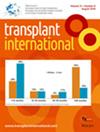International Variability of Barriers to Adherence to Immunosuppressive Medication in Adult Heart Transplant Recipients. A Secondary Data Analysis of the BRIGHT Study.
IF 2.7
3区 医学
Q1 SURGERY
引用次数: 0
Abstract
Non-adherence to immunosuppressive medication among transplant patients is associated with poor clinical outcomes and higher economic costs. Barriers to immunosuppressives are a proximal determinant of non-adherence. So far, international variability of barriers to adherence in transplantation has not been studied. As part of the cross-sectional multi-country and multi-center BRIGHT study, barriers to adherence were measured in 1,382 adult heart transplant recipients of 11 countries using the 28-item self-report questionnaire "Identifying Medication Adherence Barriers" (IMAB). Barriers were ranked by their frequency of occurrence for the total sample and by country. Countries were also ranked the by recipients' total number of barriers. Intra-class correlations were calculated at country and center level. The five most frequently mentioned barriers were sleepiness (27.1%), being away from home (25.2%), forgetfulness (24.5%), interruptions to daily routine (23.6%) and being busy (22.8%), fairly consistently across countries. The participants reported on average three barriers, ranging from zero up to 22 barriers. The majority of the variability among reported barriers frequency was situated at the recipient level (94.8%). We found limited international variability in primarily person-level barriers in our study. Understanding of barriers in variable contexts guides intervention development to support adherence to the immunosuppressive regimen in real-world settings.成人心脏移植受者坚持使用免疫抑制药物的障碍的国际差异。BRIGHT研究的二次数据分析。
移植患者不坚持使用免疫抑制剂与不良的临床疗效和较高的经济成本有关。使用免疫抑制剂的障碍是导致不坚持用药的近端决定因素。迄今为止,还没有研究过移植患者依从性障碍的国际差异。作为横断面多国多中心 BRIGHT 研究的一部分,该研究使用 28 项自我报告问卷 "识别用药依从性障碍"(IMAB)对 11 个国家的 1382 名成年心脏移植受者进行了依从性障碍测量。根据总样本和各国样本的障碍发生频率进行了排序。此外,还根据受试者的障碍总数对各国进行了排名。在国家和中心层面计算了类内相关性。最常提及的五种障碍是困倦(27.1%)、离家在外(25.2%)、健忘(24.5%)、日常工作被打断(23.6%)和忙碌(22.8%),各国的情况相当一致。参与者平均报告了三个障碍,从零到 22 个不等。所报告的障碍频率之间的差异主要集中在受助人层面(94.8%)。在我们的研究中,我们发现主要是个人层面的障碍的国际差异有限。了解不同背景下的障碍有助于制定干预措施,以支持在现实环境中坚持使用免疫抑制疗法。
本文章由计算机程序翻译,如有差异,请以英文原文为准。
求助全文
约1分钟内获得全文
求助全文
来源期刊

Transplant International
医学-外科
CiteScore
4.70
自引率
6.50%
发文量
211
审稿时长
3-8 weeks
期刊介绍:
The aim of the journal is to serve as a forum for the exchange of scientific information in the form of original and high quality papers in the field of transplantation. Clinical and experimental studies, as well as editorials, letters to the editors, and, occasionally, reviews on the biology, physiology, and immunology of transplantation of tissues and organs, are published. Publishing time for the latter is approximately six months, provided major revisions are not needed. The journal is published in yearly volumes, each volume containing twelve issues. Papers submitted to the journal are subject to peer review.
 求助内容:
求助内容: 应助结果提醒方式:
应助结果提醒方式:


